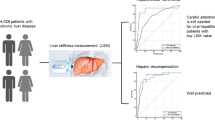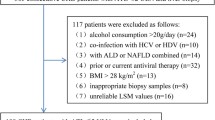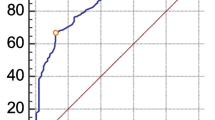Abstract
Backgroud/aims
The risk of hepatocellular carcinoma (HCC) increased with progression of hepatic fibrosis as assessed by liver stiffness measurement (LSM). This study used LSM to assess the risk of HCC presence in patients with chronic hepatitis.
Methods
The patients with liver tumor or chronic hepatitis indicated for biopsy were prospectively enrolled. LSM was performed on the same day as biopsy. The diagnostic performances of clinical parameters and LSM in predicting HCC presence were compared with the areas under receiver operating characteristics curves (AUROC). The risk of HCC presence was assessed with stratum-specific likelihood ratios (SSLR). The cut-off values and its diagnostic validity were calculated for LSM.
Results
A total of 435 patients, including 106 HCC and 329 chronic hepatitis, were enrolled. The AUROC in predicting HCC presence was 0.736, 0.733, 0.594, 0.579 and 0.532 for LSM, alpha-fetoprotein, platelet count, total bilirubin, and aspartate aminotransferase–platelet ratio index, respectively. Multivariate analysis showed liver stiffness was an independent factor for HCC presence (odds ratio 1.07, 95% confidence interval (CI) 1.05–1.09). SSLR for HCC presence by liver stiffness was 0.43 (95% CI 0.32–0.57) in <12 kPa, 1.28 (0.89–1.84) in 12–24 kPa, and 5.94 (3.77–9.35) in >24 kPa. With 12 and 24 kPa as the cut-offs in predicting HCC presence, the sensitivity was 69.8 and 41.5%, respectively. The specificity was 69.6 and 92.7%, respectively.
Conclusions
LSM identified the risk group for HCC presence in chronic hepatitis patients and had high specificity in the prediction of HCC with the cut-off of 24 kPa.


Similar content being viewed by others
References
Benvegnu L, Gios M, Boccato S, et al. Natural history of compensated viral cirrhosis: a prospective study on the incidence and hierarchy of major complications. Gut 2004;53:744–749
Fattovich G, Stroffolini T, Zagni I, et al. Hepatocellular carcinoma in cirrhosis: incidence and risk factors. Gastroenterology 2004;127:S35–S50
Yoshida H, Shiratori Y, Moriyama M, et al. Interferon therapy reduces the risk for hepatocellular carcinoma: national surveillance program of cirrhotic and noncirrhotic patients with chronic hepatitis C in Japan. IHIT Study Group. Inhibition of Hepatocarcinogenesis by Interferon Therapy. Ann Intern Med 1999;131:174–181
Bravo AA, Sheth SG, Chopra S. Liver biopsy. N Engl J Med 2001;344:495–500
Regev A, Berho M, Jeffers LJ, et al. Sampling error and inter-observer variation in liver biopsy in patients with chronic HCV infection. Am J Gastroenterol 2002;97:2614–2618
Bedossa P, Dalgere D, Paradis V. Sampling variability of liver fibrosis in chronic hepatitis C. Hepatology 2003;38:1449–1457
Piccinino F, Sagnelli E, Pasquale G, et al. Complications following percutaneous liver biopsy: a multicentre retrospective study on 68276 biopsies. J Hepatol 1986;2:165–173
Foucher J, Chanteloup E, Vergniol J, et al. Diagnosis of cirrhosis by transient elastography (FibroScan): a prospective study. Gut 2006;55:403–408
Fraquelli M, Rigamonti C, Casazza G, et al. Reproducibility of transient elastography in the evaluation of liver fibrosis in patients with chronic liver disease. Gut 2007;56:968–973
Ganne-Carrie N, Ziol M, de Ledinghen V, et al. Accuracy of liver stiffness measurement for the diagnosis of cirrhosis in patients with chronic liver diseases. Hepatology 2006;44:1511–1517
Sandrin L, Fourquet B, Hasquenoph JM, et al. Transient elastography: a new noninvasive method for assessment of hepatic fibrosis. Ultrasound Med Biol 2003;29:1705–1713
Wang JH, Changchien CS, Hung CH, et al. FibroScan and ultrasonography in the prediction of hepatic fibrosis in patients with chronic viral hepatitis. J Gastroenterol 2009;44:439–446
Masuzaki R, Tateishi R, Yoshida H, et al. Risk assessment of hepatocellular carcinoma in chronic hepatitis C patients by transient elastography. J Clin Gastroenterol 2008;42:839–843
Hanley JA, McNeil BJ. The meaning and use of the area under a receiver operating characteristic (ROC) curve. Radiology 1982;143:29–36
Hanley JA, McNeil BJ. A method of comparing the areas under receiver operating characteristic curves derived from the same cases. Radiology 1983;148:839–843
Peirce JC, Cornell RG. Integrating stratum-specific likelihood ratios with the analysis of ROC curves. Med Decis Making 1993;13:141–151
Furukawa TA, Goldberg DP, Rabe-Hesketh S, et al. Stratum specific likelihood ratios of two versions of the general health questionnaire. Psychol Med 2001;31:519–529
Friedrich-Rust M, Ong MF, Martens S, et al. Performance of transient elastography for the staging of liver fibrosis: a meta-analysis. Gastroenterology 2008;134:960–974
Castéra L, Le Bail B, Roudot-Thoraval F, et al. Early detection in routine clinical practice of cirrhosis and oesophageal varices in chronic hepatitis C: comparison of transient elastography (FibroScan) with standard laboratory tests and non-invasive scores. J Hepatol 2009;50:59–68
Szabó E, Páska C, Kaposi Novák P, et al. Similarities and differences in hepatitis B and C virus induced hepatocarcinogenesis. Pathol Oncol Res 2004;10:5–11
Gurtsevitch VE. Human oncogenic viruses: hepatitis B and hepatitis C viruses and their role in hepatocarcinogenesis. Biochemistry (Mosc). 2008;73:504–513
Sagir A, Erhardt A, Schmitt M, et al. Transient elastography is unreliable for detection of cirrhosis in patients with acute liver damage. Hepatology 2008;47:592–595
Nahon P, Kettaneha A, Lemoine M, et al. Liver stiffness measurement in patients with cirrhosis and hepatocellular carcinoma. Eur J Gastroenterol Hepatol 2009;21:214–219
Masuzaki R, Tateishi R, Yoshida H, et al. Prospective risk assessment for hepatocellular carcinoma development in patients with chronic hepatitis C by transient elastography. Hepatology 2009;49:1954–1961
Del Poggio P, Colombo S. Is transient elastography a useful tool for screening liver disease? World J Gastroenterol 2009;15:1409–1414
Bruix J, Sherman M, Practice guidelines committee, American Association for the Study of Liver Diseases. Management of hepatocellular carcinoma. Hepatology 2005;42:1208–1236
Kudo M, Okanoue T, Japan Society of Hepatology. Management of hepatocellular carcinoma in Japan: consensus-based clinical practice manual proposed by the Japan Society of Hepatology. Oncology 2007;72:S2–S15
Lu SN, Wang JH, Liu SL, et al. Thrombocytopenia as a surrogate for cirrhosis and a marker for the identification of patients at high-risk for hepatocellular carcinoma. Cancer 2006;107:2212–2222
Sinn DH, Paik SW, Kang P, et al. Disease progression and the risk factor analysis for chronic hepatitis C. Liver Int 2008;28:1363–1369
Acknowledgement
This study was supported by a grant from Chang Gung Memorial Hospital (CMRP G850141) to Sheng-Nan Lu. The authors thank C.Y. Lin for her excellent assistance in statistics and C.L. Li for her secretarial assistance.
Author information
Authors and Affiliations
Corresponding author
Rights and permissions
About this article
Cite this article
Kuo, YH., Lu, SN., Hung, CH. et al. Liver stiffness measurement in the risk assessment of hepatocellular carcinoma for patients with chronic hepatitis. Hepatol Int 4, 700–706 (2010). https://doi.org/10.1007/s12072-010-9223-1
Received:
Accepted:
Published:
Issue Date:
DOI: https://doi.org/10.1007/s12072-010-9223-1




